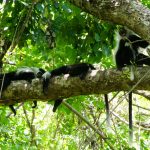Simple Steps to Help Save Tropical Forests

Over the past two columns, I’ve been writing about some of the many issues which tropical forests worldwide are facing, and a few of the ways in which Flamingo Land’s Udzungwa Forest Project is trying to help matters. The project has now been running for seven years, and though Magombera Forest still lacks formal legal protection from the Tanzanian government, things are beginning to look up! In 2011, the project was awarded Best Field Conservation Project by the British and Irish Association of Zoos and Aquariums, and in 2013 its parent organisation CIRCLE received the PraxisUnico Collaborative Impact Award for achieving significant impact in biodiversity conservation and environmental education – mostly through its’ work with UFP.
Our team of field scientists visits Magombera Forest on a daily basis, carrying out surveys to measure a number of biological indicators and track their progress over time. These help us to determine whether the forest is recovering or still losing biomass, allowing us to focus our efforts where they can be of most use. Initial results are promising: despite the lack of legal protection, the forest remains for the most part intact! Although the numbers of trees and monkeys have shown slow declines over time, they have not fallen below our targets. The team have also been experimenting with novel forest restoration methods in an attempt to reverse this decline, which has seen both biodiversity (i.e. the number of species seen) and biomass (i.e. the amount of growth) increase in restored areas. A new species of tree was discovered in the area by Flamingo Land’s Director of Conservation, and the honour of naming it will go to a local Yorkshire school as part of a UFP fundraiser in early 2015! Watch this space for more details very soon.
So what can you do at home to help conserve tropical forests? Aside from supporting projects like UFP, there are a few simple things you can do to reduce your impact on the environment. When buying wood products like furniture and paper, look for the FSC certification logo so you know it has been sourced responsibly. And next time you’re in the supermarket, take a look at the ingredient labels on the food and cosmetics you buy. Palm oil is an ingredient in thousands of products worldwide but as a high-yield, high-profit crop it is responsible for much of the deforestation currently seen in tropical forests. Though previously difficult to avoid as it was often simply labelled as vegetable oil, new EU labelling laws beginning from December 2014 require manufacturers to label their products transparently. Keep an eye out and you may be surprised to find how many products actually contain it!
Michael Darling, Education Marketing Officer
Photo: our Tanzanian field scientists measuring conservation indicators


